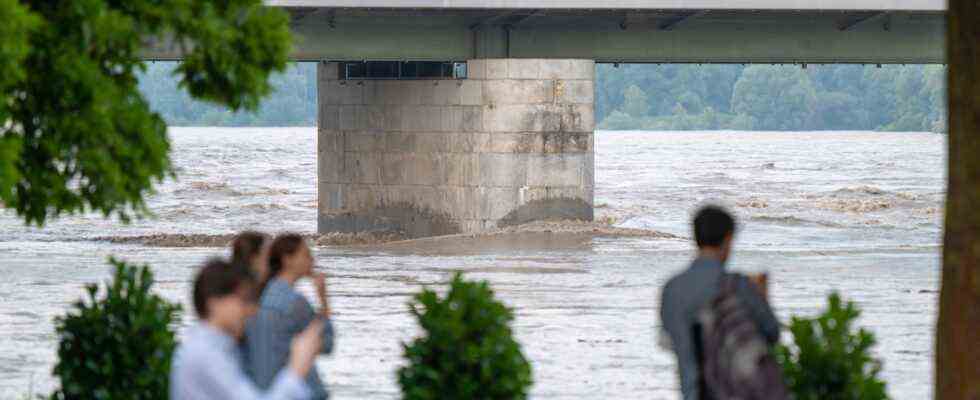Status: 07/19/2021 8:10 a.m.
The tidying up continues in the west, today Interior Minister Seehofer is visiting particularly affected areas. In Bavaria, the flood situation is still tense – in Passau the water of the Danube remains briefly below the highest warning level.
While there is no acute risk of storms in western Germany for the time being, there are still anxious glances at some places. Federal Minister of the Interior Horst Seehofer is visiting the areas in North Rhine-Westphalia and Rhineland-Palatinate that have been particularly hard hit by the flood disaster and major destruction. For example, he is expected at the Steinbachtalsperre in Euskirchen, where a dam breach was still not ruled out recently.
In Bavaria, meanwhile, the flood situation in the south and east of the state remained tense, but did not worsen during the night. In Passau the water levels rose into the night, but then remained at a high level. At least reassuring: Last night there were no more severe weather warnings from the German Weather Service (DWD) in force. The meteorologists predicted that the rains in the Alps would subside at night. Thunderstorms cannot be ruled out during the day in Bavaria. Overall, however, Germany is facing a relatively calm period of weather in the next few days with quite dry air.
Apart from rubble, not much remains
Eva-Maria Class, BR, Morgenmagazin, 7/19/2021
More than 160 dead
The number of confirmed fatalities due to the devastating floods in Germany rose to almost 160 over the weekend. In the Ahrweiler district in Rhineland-Palatinate, the police reported 110 deaths, while the number in North Rhine-Westphalia had risen to 46. In addition, at least one person was killed in Upper Bavaria.
It is the worst flood disaster in Germany in decades. In the middle of the week it had rained unusually hard, especially in western Germany. Many houses, streets and bridges are in ruins.
Still great danger in Erftstadt-Blessem
According to experts, in Erftstadt-Blessem there is still an acute danger to life near a demolition edge, as District Administrator Frank Rock announced after a conversation with the experts on site. The stability of the subsoil after the storm in the particularly affected district must continue to be checked. In Blessem, the floods had created a huge crater, at least three houses and part of the historic castle collapsed.
In Passau in the very south-east of Germany, the water level of the Danube rose only slightly on Monday night and then remained below the mark of 8.50 meters, from which the highest flood warning level applies. The promenade and parking lots were already flooded, residents protected houses with sandbags and barriers. In the Berchtesgadener Land in Upper Bavaria, the force of the water had already struck at full speed on the weekend because the river Ache overflowed its banks. More than 160 people had to be brought from their homes to safety in the holiday region around the Königssee, as a spokeswoman for the district office said on Sunday evening.
In western Germany, Seehofer wants to get an idea of the work of the Technical Relief Agency (THW) on site. It is subordinate to the Federal Ministry of the Interior. According to the information, the organization has 2,500 helpers in the flood areas to bring people to safety, pump out basements, ensure the power supply and remove piles of rubble.
Seehofer visits Steinbachtalsperre and Ahrweiler
Seehofer is expected at the Steinbachtalsperre in Euskirchen (North Rhine-Westphalia) in the late morning. There had been a setback there because the water drained more slowly than expected. In the morning, experts want to decide when people in the evacuated areas will be allowed to return to their homes. The Euskirchen fire brigade denied rumors about the break of the dam on Sunday evening.
Visiting the crisis area: a fine line for politicians
Anja Köhler, ARD Berlin, morning magazine, July 19, 2021
Around noon, Seehofer then wants to go to Bad Neuenahr-Ahrweiler (Rhineland-Palatinate) to visit a hospital. THW has installed a drinking water treatment system there so that the hospital can continue to get the drinking water it needs. This became necessary after the masses of water damaged the pipes in the vicinity of the clinic.
After Chancellor Angela Merkel, Federal Finance Minister Olaf Scholz and Federal President Frank-Walter Steinmeier, Seehofer is another federal politician who travels to the disaster area to assure the people there of his support.

